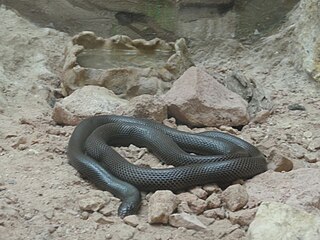
The California ground squirrel, also known as the Beechey ground squirrel, is a common and easily observed ground squirrel of the western United States and the Baja California Peninsula; it is common in Oregon and California and its range has relatively recently extended into Washington and northwestern Nevada. Formerly placed in Spermophilus, as Spermophilus beecheyi, it was reclassified in Otospermophilus in 2009, as it became clear that Spermophilus as previously defined was not a natural (monophyletic) group. A full species account was published for this species in 2016.

Hydrophiinae is a subfamily of venomous snakes in the family Elapidae. It contains most sea snakes and many genera of venomous land snakes found in Australasia, such as the taipans (Oxyuranus), tiger snakes (Notechis), brown snakes (Pseudonaja) and death adders (Acanthophis).

The Typhlopidae are a family of blind snakes. They are found mostly in the tropical regions of Africa, Asia, the Americas, and all mainland Australia and various islands. The rostral scale overhangs the mouth to form a shovel-like burrowing structure. They live underground in burrows, and since they have no use for vision, their eyes are mostly vestigial. They have light-detecting black eye spots, and teeth occur in the upper jaw. Typhlopids do not have dislocatable lower jaw articulations restricting them to prey smaller than their oral aperture. The tail ends with a horn-like scale. Most of these species are oviparous. Currently, 18 genera are recognized containing over 200 species.

The Anomalepididae are a family of nonvenomous snakes, native to Central and South America. They are similar to Typhlopidae, except that some species possess a single tooth in the lower jaw. Currently, four genera and 15 species are recognized. Common names include primitive blind snake and dawn blind snake.

The Leptotyphlopidae are a family of snakes found in North America, South America, Africa and Asia. All are fossorial and adapted to burrowing, feeding on ants and termites. Two subfamilies are recognized.
The Uropeltidae, also commonly known as shield tail snakes, shield-tailed snakes or earth snakes, are a family of primitive, nonvenomous, burrowing snakes native to Peninsular India and Sri Lanka. The name is derived from the Greek words ura ('tail') and pelte ('shield'), indicating the presence of the large keratinous shield at the tip of the tail. Seven or eight genera are recognized, depending on whether Teretrurus rhodogaster is treated in its own genus or as part of Brachyophidium. The family comprises over 50 species. These snakes are not well known in terms of their diversity, biology, and natural history.

Drymarchon is a genus of large nonvenomous colubrid snakes, commonly known as indigo snakes or cribos, found in the Southeastern United States, Central America, and South America.

Atractaspis is a genus of venomous snakes in the family Atractaspidae, also known as the stiletto snakes. The genus is endemic to Africa and the Middle East. The genus contains 15 species that are recognized by ITIS. Others recognize as many as 21 species. 23 are listed here.

Ophichthidae is a family of fish in the order Anguilliformes, commonly known as the snake eels. The term "Ophichthidae" comes from Greek ophis ("serpent") and ichthys ("fish"). Snake eels are also burrowing eels. They are named for their physical appearance, as they have long, cylindrical, snake-like bodies. This family is found worldwide in tropical to warm temperate waters. They inhabit a wide range of habitats, from coastal shallows and even rivers, to depths below 800 m (2,600 ft). Most species are bottom dwellers, hiding in mud or sand to capture their prey of crustaceans and small fish, but some are pelagic.

Ophiderpeton is an extinct genus of aistopod tetrapodomorphs from the early Carboniferous to the early Permian. Remains of this genus are widespread and were found in Ohio, United States, Ireland, and the Czech Republic.

Dinilysia is an extinct genus of snake from the Late Cretaceous (Coniacian) of South America. Dinilysia was a relatively large ambush predator, measuring approximately 2 m (6.6 ft) long. The skull morphology of Dinilysia is similar to boids, suggesting that it was able to consume large prey. Living in a desert-like environment, Dinilysia is likely a terrestrial or a semi-fossorial animal.

Adelphicos is a genus of New World burrowing snakes in the family Colubridae. The genus consists of nine species.

The Alethinophidia are an infraorder of snakes that includes all snakes other than blind snakes and thread snakes. Snakes have long been grouped into families within Alethinophidia based on their morphology, especially that of their teeth. More modern phylogenetic hypotheses using genetic data support the recognition of 19 extant families, although the taxonomy of alethinophidian snakes has long been debated, and ultimately the decision whether to assign a particular clade to a particular Linnaean rank is arbitrary.
Burrowing snake may refer to:
Mehelya is a genus name of colubrid snakes from Africa. Some species formerly assigned to the genus Mehelya are now found in the genera Gonionotophis, Gracililima, or Limaformosa. They are collectively called file snakes due to their unusual scalation. They are not venomous.
Menarana is an extinct genus of madtsoiid snake which existed in Madagascar during the Late Cretaceous. The type species is Menarana nosymena. Several vertebrae and rib fragments as well as part of the basicranium have been found from the Maastrichtian-age Maevarano Formation in the Mahajanga Basin.

Apostolepis is a genus of snakes in the subfamily Dipsadinae. However, the familial placement differs among sources. It has also been placed in the family Colubridae, subfamily Dipsadinae or Xenodontinae, or in the family Xenodontidae. The genus Apostolepis is endemic to South America.

Pseudorabdion is a genus of snakes of the family Colubridae.
The Warrego burrowing snake is a species of snake native to western Queensland.
The northeastern plain-nosed burrowing snake is a species of snake native to far north Queensland.













